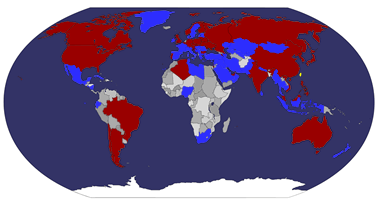The 60th Anniversary of Enforcement of the Local Autonomy Law - Aomori Prefecture/
Le 60ème Anniversaire de Mise en vigueur de la Loi d'Autonomie Locale - la Préfecture d'Aomori
Aomori Prefecture (青森県 Aomori-ken) is a prefecture of Japan located in the Tōhoku Region. The capital is the city of Aomori.
Aomori Prefecture came into existence in 1871. Aomori Town was established in 1889. The town was incorporated as a city in 1898 with a population of 28,000. On May 3, 1910 a fire broke out in the Yasukata district. Fanned by strong winds, the fire quickly devastated the whole city. The conflagration claimed 26 lives and injured a further 160 residents. It destroyed 5,246 houses and burnt 19 storage sheds and 157 warehouses.
At 10:30 p.m. on July 28, 1945 a squadron of American B29 bombers bombed over 90% of the city.
Radio Aomori (RAB) made its first broadcast in 1951. Four years later, the first fish auctions were held. 1958 saw the completion of the Municipal Fish Market as well as the opening of the Citizen's Hospital. In the same year, the Tsugaru Line established a rail connection with Minmaya Village at the tip of the peninsula.
Various outlying towns and villages were incorporated into the growing city and with the absorption of Nonai Village in 1962, Aomori became the largest city in the prefecture.
In March 1985, after 23 years of labor and a financial investment of 700 billion yen, the Seikan Tunnel finally linked the islands of Honshū and Hokkaidō, thereby becoming the longest tunnel of its kind in the world.[citation needed] Almost exactly three years later, on March 13, railroad service was inaugurated on the Tsugaru Kaikyo Line.
That same day saw the end of the Seikan Ferry service. During their 80 years of service, the familiar ferries of the Seikan line sailed between Aomori and Hakodate some 720,000 times, carrying 160 million passengers.
In April 1993, Aomori Public College opened. In August 1994, Aomori City made an "Education, Culture and Friendship Exchange Pact" with Kecskemet in Hungary. One year later a similar treaty was signed with Pyongtaek in South Korea, and cultural exchange activities began with exchanges of woodblock prints and paintings.
In April 1995, Aomori Airport began offering regular international air service to Seoul, South Korea, and Khabarovsk, Russia.
In June 2007, four North Korean defectors reached Aomori Prefecture, after having been at sea for six days, marking the second known case ever where defectors have successfully reached Japan by boat.
Aomori Prefecture is the northernmost prefecture on Honshū and faces Hokkaidō across the Tsugaru Strait. It borders Akita and Iwate in the south. Oma, at the northwestern tip of the axe-shaped Shimokita Peninsula, is the northernmost point of Honshū. The Shimokita and Tsugaru Peninsulas enclose Mutsu Bay. Between those peninsulas lies the Natsudomari Peninsula, the northern end of the Ōu Mountains. The three peninsulas are prominently visible in the prefecture's symbol, a stylized map.
Lake Towada, a crater lake, straddles Aomori's boundary with Akita.
La préfecture d'Aomori (青森県, Aomori-ken) occupe l'extrême nord de l'île de Honshū, la principale île du Japon. Elle fait face à l'île de Hokkaidō.
La préfecture d’Aomori fut fondée en 1871. Son chef-lieu, Aomori, fut établi en 1889 et constituée comme ville en 1898. Elle était alors peuplée de 28 000 habitants.
Le 3 mai 1910, un incendie éclata dans le district Yasukata et dévasta toute la ville en moins de 4 heures. L'incendie fit 26 morts, 160 blessés et détruisit 5.246 habitations.
À la fin de la Seconde Guerre mondiale, le 28 juillet 1945, un escadron de bombardiers américains survola Aomori et bombarda plus de 90% de la ville en moins de deux heures.
Radio Aomori fit sa première diffusion en 1951.
En 1955 sont tenues les premières criées de poissons, et 1958 célébra l'achèvement du Marché Municipal aux Poissons ainsi que l'ouverture de l'Hôpital Municipal. Cette même année, la ligne Tsugaru établit une connexion ferroviaire avec le village Minmaya, à la pointe de la péninsule.
À la même époque, différentes villes et villages isolés furent incorporés à la ville en pleine croissance. L'absorption du village de Nonai en 1962 fit d’Aomori la plus grande ville de la préfecture.
En mars 1985, après 23 ans de travail et un investissement financier de 700 milliards de yens, le tunnel du Seikan relia enfin les îles de Honshū et Hokkaidō, devenant ainsi le plus long tunnel de son genre du monde.
En avril 1993, les efforts de la ville d'Aomori et d'un groupe de six autres collectivités locales furent récompensés par l'ouverture du Lycée Public d’Aomori.
En août 1994, la ville d'Aomori établit un "Pacte amical d’éducation, de culture et d'échange" avec Kecskemet en Hongrie, puis l’année suivante avec la ville Pyongtaek en Corée du Sud. L’échange culturel débuta par des échanges d'estampes et de peintures.
En avril 1995, l'aéroport d'Aomori devient le premier de la région du Tōhoku à offrir des services aériens internationaux réguliers à destination de Séoul en Corée du Sud et de Khabarovsk en Russie.
En juin 2007, quatre réfugiés nord-coréens ont atteint la préfecture d'Aomori après six jours en mer, devenant ainsi le deuxième cas officiellement connu où des réfugiés réussirent à atteindre le Japon par bateau.
La préfecture d’Aomori se situe à l’extrême nord de Honshū, région également appelée le Tōhoku.
Elle est bordée au sud par les préfectures d'Akita et d'Iwate, et au nord par la baie de Mutsu et le détroit de Tsugaru.
Elle possède deux péninsules, Shimokita et Tsugaru.
Le lac Towada, un lac de caldeira, longe les frontières sud de la préfecture partagées avec Akita.
La préfecture compte 10 villes et 8 districts comprenant un total de 22 bourgs et 8 villages.










.jpg)























 taiwan
taiwan  cover or postcard
cover or postcard  FDC
FDC 






























































































No comments:
Post a Comment